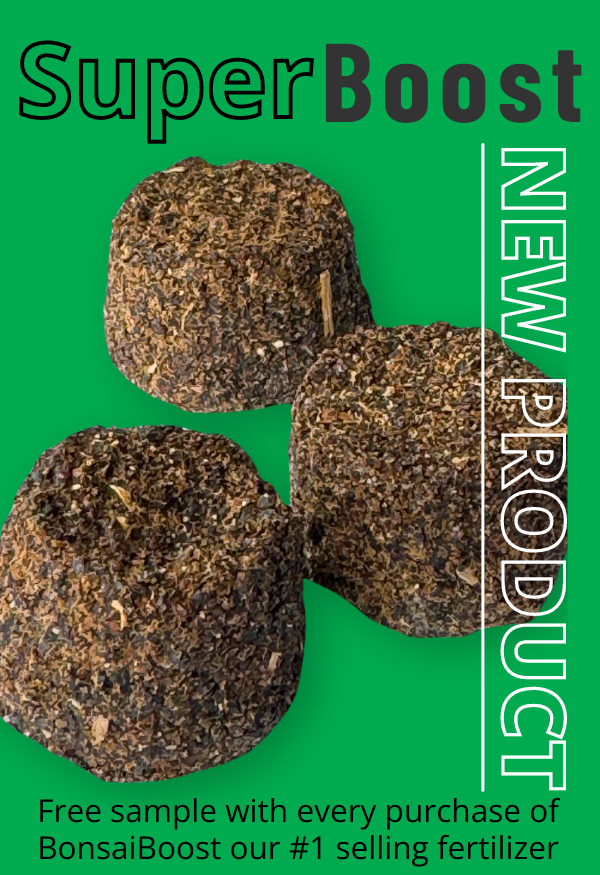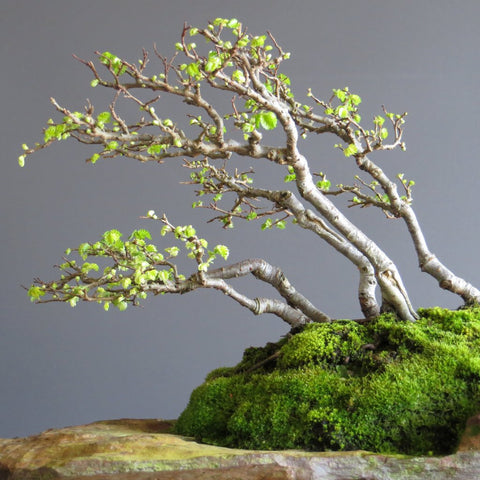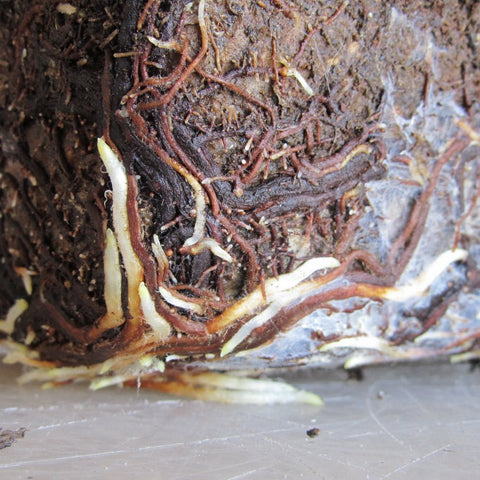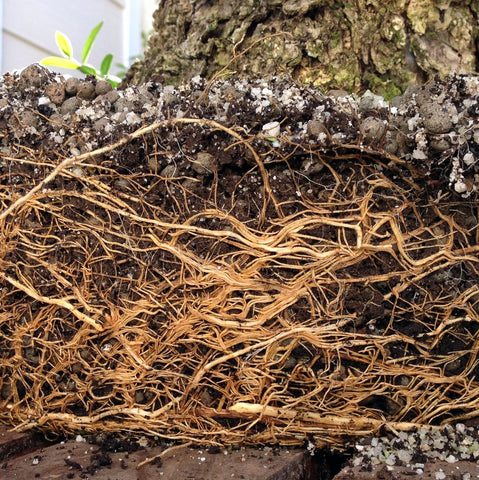Your Cart is Empty
spend R1000. 2kg or less. free shipping.
Menu

spend R1000. 2kg or less. free shipping.
bonsai
gardening
Orchids

The Why and When of Repotting your bonsai trees
8 min read
Why do we need to repot?
Unlike trees growing in the open ground where their roots have a large soil volume in which to grow, our bonsai grow in a very restricted space. As the bonsai tree continues to grow, so does it's roots. If we do not wish to up-size the pot then we need to reduce the root ball not only that it will continue to fit but that it will regain health as pot bound trees are usually weak. A tree will actually begin pushing itself out of its pot after a couple years, this is especially so in species with strong root systems like Chinese maples.
After a few years the structure of your growing medium will begin to collapse, holding more water and reducing oxygen at the roots as it becomes more and more compacted. This slows the growth of the tree down and can lead to various problems such as root rot. If the tree is not repotted it will slowly deteriorate in health and die.
Lastly, the kind of roots we want in bonsai cultivation are the fine, feeder roots which gather nutrients and water as these are the roots which lead to and can support ramified trees. We do not want the thicker storage roots which eventually develop after a number of years. So when we repot, these are removed and the fine roots are encouraged. Its a very interesting fact that when you look at a tree and the level of branching or ramification this is mirrored in the roots below. You will never find a bonsai tree with impressive ramification and then below the ground a few long, coiling roots.
There are probably more reasons but these are the most important ones that come to mind and are important for this discussion.
Image: New leaves and swelling buds on deciduous. At this time, or even a little earlier, is the best time to start repotting ie. when buds begin to swell.
When to repot
The "when" is a little tricky to answer precisely. For those of you new to bonsai I would suggest you speak with someone who has been growing bonsai in your area and ask them when they repot their trees. If this is not possible there are several other potential sources of local information including your local bonsai nursery or local club. I would generally treat any repotting schedules you might get from a book printed in a foreign country or even schedules from forums and Facebook groups with caution. These are often written by highly capable growers but in a climate different to yours. I would also be weary of statements where a date is given as seasons, in my experience, and weather patterns are constantly changing.
What your trees are doing or not doing is really the best indicator of the "when."
Generally speaking we want to repot the tree when it is just showing signs of activity, as it emerges from winter dormancy although there are other times in the year when certain species can be repotted (These times are frequently not optimal and some experience is need both in the amount of roots which can be removed and post repotting care). In deciduous trees this is evident by the swelling of the new buds on the branches. Just as the buds are about to burst and the new leaves reveal themselves is the optimal time. At this stage the tree has pushed a lot of sap up from the root system and thus by trimming the roots now, the tree will have enough energy to continue growing. In converse, repotting too early can severely weaken the tree as you deprive it of the energy needed to grow or it could even kill it. Repotting too late and the tree does not have sufficient roots to take up water in order to support the spring growth it has just exerted all its energy on producing.
Evergreens are a little different as they of course already have leaves on them. Very often with deciduous trees they begin showing signs of growth quite early in spring, when it is still quite cold. However with evergreens they tend to wake up a little later, when it is warmer. Of course they do not have buds which swell, but rather new growth in the form of new foliage in junipers and extension of candles in pines. One way to double-check that the tree is active is to lift the entire tree and it's root ball from the pot and inspect the roots. You should see a lot of new roots, with tips white in appearance.
Image: The roots of this Japanese black pine tree are showing signs of growth indicating that now would be a good time to repot.
How often should I repot
Frequency of repotting should probably also fall under this "when" section too. Normally younger trees are repotted more frequently as they are faster growers and fill the pot with roots rather rapidly, so possibly every 2 - 3 years (Repotting more frequently also produces more growth too as it energizes the tree by providing better aeration of the root system and as fine hair roots are produced, replacing the mature storage roots which were largely removed).
Mature trees should not be repotted too often, perhaps only up to every 5 years. This is as you want their growth to slow down in order to maintain the fine network of twigs which you so laboriously have cultivated.
I generally will also repot regardless of the period since the last repotting, if I see that drainage has been impeded or if the tree is about to pop out of the pot.
If you can visibly see that water is not entering the media as well as it used to then it might require only removing the top layer of media and fine roots with the use of a thick chopstick or fine rake. Often times this will resolve the problem and a full repot will not be necessary. If however when you try scraping the top layer away and see that the rest of the soil has compacted and broken down then it would be best to proceed to repotting.
Don't repot just for the sake of repotting as everyone else is doing it. Repot because you have a reason to do so and a goal in mind.
A more in-depth explanation around this is possible but for now I think this simple statement is all that's necessary. Feel free to read more about repotting here though.
Growing mediums for growing bonsai trees
We cannot have a blog post about repotting and not mention anything about growing mediums. They say that for as many bonsai growers there are in the world, that's how many variations of growing mediums there are! I'd bet they're not exaggerating! However there are a couple basics which I believe will help you either to select the right growing medium or to help you mix your own.
Firstly, notice that I do not use the word "soil." Although trees do grow very well in soil, this is in your garden. In a pot, soil or at least the conventional understanding of what it is creates too many problems. These includes insufficient drainage (potentially leading to rotted roots), deprivation of oxygen, compaction and more.
The next fundamental concepts to understand is that there are essentially 2 components to all growing mediums; organic and inorganic although you may not always use organics and in fact the trend today is to use so called organic free growing mediums. Organic includes material which will degrade (rot), inorganic is a component which does not originate from from plant sources.
Organic components
This includes mature milled pine bark, peat, compost or other such ingredients. Organic material is used largely for moisture retention and as we believe we need it as a supply of nutrients to the tree. How much you use will depend on how often you are able to water. Keeping a tree's roots wet for extended periods can result in diseases which attack the roots though, such as root rot. It also slows growth down as the roots need oxygen to grow and if the air pockets are filled with water it is deprived of that oxygen. Whatever your choice of organic medium it's a good idea to sift the fine particles out as they tend to clog the mixture.
A personal observation of mine is that when I used to use significant amounts of organic medium in my mix I often discovered white grubs - a very undesirable discovery. Turns out that the adult lays its eggs where decaying organic material can be found and that the developing larva feed on it and also the occasional root of your bonsai tree! Although one can use pesticides such as Plant Care to eradicate these pests, I personally find it better to avoid organics altogether.
You can also add milled seaweed to your mix when repotting your tree. This organic component does retain some moisture but it is primarily a slow release source of nutrients.
Inorganic components
Such as Akadama, Pumice, crushed lava stone, crushed silica sand, river sand, LECA, Groperl and vermiculite help to maintain the mediums structure as they do not degrade like the organic component, or at least not as quickly in some cases. Most absorb moisture and release it at varying rates, aside from impervious materials like most stone of course. However they generally are not able to absorb much so using a very inorganic mix will mean you will be more watering frequently. This results in very good root development as trees are forced to send out many more feeder roots in an effort to find sufficient moisture and nutrients to support life. And it therefore stands to reason that you will have healthy foliage development too.
Image: LECA is a very good base to use for your growing medium as it promotes drainage and provides lots of oxygen for healthy roots.
A few mixes
Traditionally a very basic, all round mix is generally 50:50 of organic and inorganic material which is how we produce our Bonsai General Soil Mix. However so many factors determine this ratio including:
- your ability to water
- your local climate
- the species of tree
- and the stage of development of that tree.
So experiment with different ratios and different ingredients to see what works best for you and your lifestyle.
A more contemporary mix is the Bonsai Professional Growing Medium which consists of 80:20 Leca/Peat mix. The Leca we use has a particle size of roughly 2-4mm and is crushed. The peat is a very long fibred type so it does not readily compact and as it is already thoroughly decomposed it will not change much in structure during its usable life in a container.
If however you want the best growth then you should consider a medium comprised of Akadama, Hyuga (Japanese Pumice), crushed fujizuna (lava stone) and a little agricultural carbon. This is today probably the most widely used mix in the world.
You can either mix these in a 1:1:1 ratio or increase the ratio of Akadama for a more water retentive mix. These mediums also come in various sizes namely; fine, small and medium and it is important that you use the correct particle size for your needs.
The benefit of using the different sizes allows you to manipulate oxygen flow and water retention.
Finer particles, when used on the top will promote surface rooting or will enable you to use smaller containers when growing shohin and mame sized trees.
Small particles are ideal for the average size tree and containers.
Medium particles are best for collected trees and or at the bottom of large containers to increase airflow in this area which will assist with drying this zone which is typically susceptible to root root.
You may wish to add Leca or crushed stone to an akadama/pumice/lava mix for certain gains however please do not add organic material to it such as bark, peat or other.
Please do take the time to download this e-book I wrote on growing mediums. It goes into greater depth than this article attempts to and will equip you with the knowledge needed to arrive at the best growing medium for you and your circumstances.
6 Responses
Terry
October 15, 2015
Thanks for the question Des! The river sand I have seen in stores is too fine, you really shouldn’t be using anything smaller than about 2mm in your mix. In my “professional mix” and “general soil mix” the crush silica stone is used and it is graded 2 – 4mm. You could probably buy crushed silica stone at your local pool supply store as it is used in filters. Stores selling koi may also have it as it is also used in their filtration systems. You can almost use any inorganic component of sufficient size (>2mm) to promote drainage. I prefer using more LECA than stone as it does absorb and retain some moisture PLUS its much lighter when you are working with large trees. Hope I’ve answered your question.
Des
October 15, 2015
We generally buy river sand from the local hardware. Is it sufficient for quick drainage and air flow or should it be sieved to collect the bigger sand particles. Is it fine to mix small crashed stone with the mix to encourage fast drainage. Thanks
Terry
October 03, 2015
Thanks for the question Paul. What is the condition of the roots of the baobab in your normal mix? If they are healthy then I see no reason to change. In my climate I would say that your mix might be a little too organic and I would use more LECA, however that’s me. I also don’t know what growing conditions baobabs prefer i.e. a drier or wetter mix, as I don’t grow baobabs. From what I know they prefer drier, faster draining mixes
Paul
October 03, 2015
What growing medium mix would you recommend for repotting a baobab tree. My normal mix is about 40% potting soil, 30% coarse river sand and 30% Leica. I live in Hillcrest KZN and water with a drip / spray irrigation system every second day.
Jan Vosloo
August 15, 2015
Very knowledgeable
Leave a comment
Comments will be approved before showing up.
Recent Articles
- Enthusiasts Top Wiring Tips July 17, 2023
- Top fertilizing tips March 28, 2023
- Top watering tips February 13, 2023
- Creating Japanese Maple forests October 24, 2022
- How to dig bonsai material August 15, 2022
- How I style bonsai and you can too April 30, 2022
- Swamp Cypress Bonsai Styling July 03, 2021
- How to hide large scars quickly June 14, 2021
- 14 Tips for Field Growing Bonsai May 31, 2021
- Aquaria: An Introduction January 06, 2021

FREE SAMPLE GIVEAWAY!
We are giving away samples of our new product, SuperBoost fertilizer pellets.
A unique organic blend of Blood meal, Bone meal, Canola meal, Fish meal, Fish hydrolysate. Macro, micro and trace minerals. Plant natural stimulating hormones, enzymes and amino acids.








Malcolm
October 06, 2016
Afternoon Paul. Realize your above mail is now over a year old and maybe you won’t see my mail but I was reading backwards thro’ Terry’s bolgs the other day.
I live in Jo’burg and have 5 baobabs grown from seed – the oldest is about 10 and the youngest hails from last summer.
I use a very porous mix of about 25% compost and 75% course river sand, or sand and leca mixed, and I rarely water them at all.
They live in a very sheltered, sunny corner and when it stops raining up here in March/April they go into that corner and I don’t water them at all right thro’ to September/October when it starts to rain again.
When the green leaf tips appear, round about now, they might get one soaking and then they move out of their sheltered corner onto a patio table [not sure my wife likes that too much] and they then get watered when it rains.
If I feel it’s been raining too much they go back to their corner for a day or three.
My theory here is that’s how they survive above The Tropic of Capricorn and my trees, so far, are doing just fine.